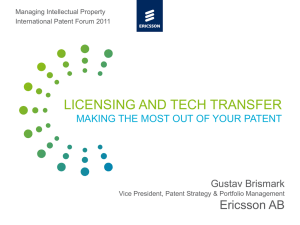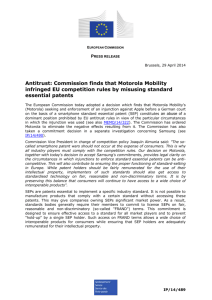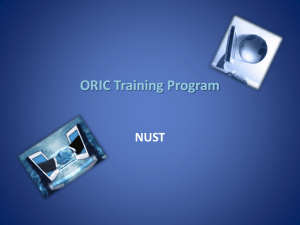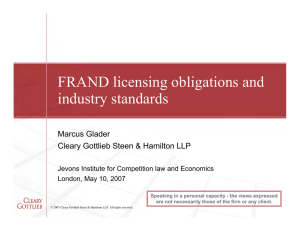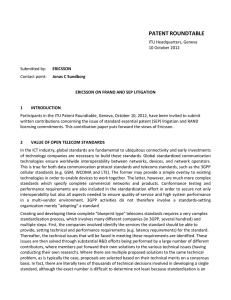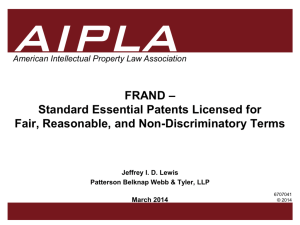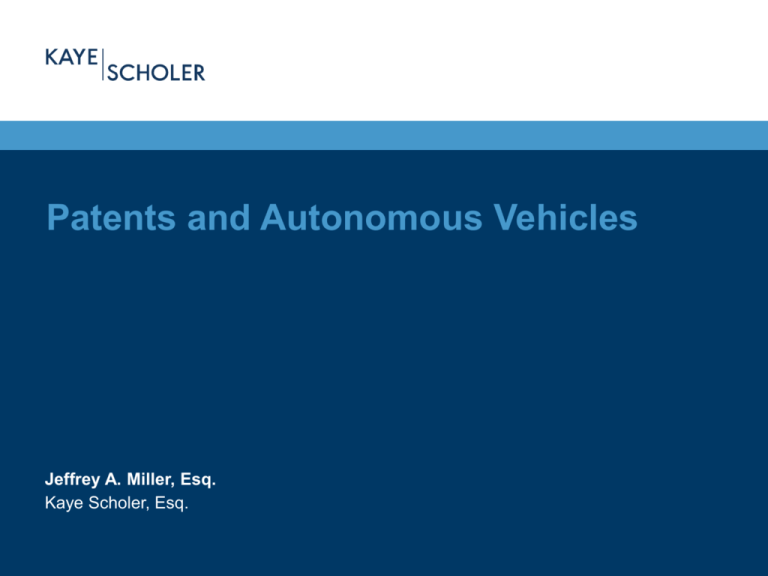
Patents and Autonomous Vehicles
Jeffrey A. Miller, Esq.
Kaye Scholer, Esq.
The Patent Landscape
• The automotive industry generates thousands of patents
• According to Thomson Reuters, worldwide patent filings in the automotive industry
lag only computing/peripherals and telecommunications:
Thomson Reuters, 2014 State Of Innovation Report, available at
http://ip.thomsonreuters.com/sites/default/files/2014stateofinnovation.pdf
2
The Patent Landscape
• The automotive industry generates thousands of patents
• According to Thomson Reuters, worldwide patent filings in the automotive industry
lag only computing/peripherals and telecommunications:
Thomson Reuters, 2014 State Of Innovation Report, available at
http://ip.thomsonreuters.com/sites/default/files/2014stateofinnovation.pdf
3
The Patent Landscape
• The number of patents in the industry is increasing
Thomson Reuters, The State of innovation in the Automotive Industry 2015, available at
http://ip-science.thomsonreuters.com/ip/SOI-Automotive-Industry-Report.pdf
4
The Patent Landscape
• Thomson Reuters reports that Toyota,
TM and Hyundai are most active patent
filers for autonomous driving patents
Thomson Reuters, The State of innovation in the Automotive Industry 2015,
http://ip-science.thomsonreuters.com/ip/SOI-Automotive-Industry-Report.pdf
5
The Patent Landscape
• Thomson Reuters reports that Bosch,
Audi, BMW, Continental, Daimler,
Valeo and Volkswagen are most active
patent filers for Driver Assistance
patents
Thomson Reuters, The State of innovation in the Automotive Industry 2015,
http://ip-science.thomsonreuters.com/ip/SOI-Automotive-Industry-Report.pdf
6
The Patent Landscape
• I compiled my own data using the Cooperative Patent Classification (“CPC”) system
used by U.S. Patent and Trademark Office
• Classes include autonomous vehicles and driver assist technologies since both are
likely important in litigation and licensing environments
– Also include analogous technologies such as video processing, navigation, active
safety, etc.
• Classes (and subclasses) intentionally chosen to be over inclusive, but some manual
culling was performed
• No date limit
• Data include both issued patents and published applications
• USA only
7
8
Volvo
Volkswagen Group
Velodyne
Uber
Toyota
Tesla
Tata
SAIC
Renault
Quanergy
Qualcomm
nVidia
Nissan
MobilEye
Mercedes/Daimler
Mazda
Magna
LG
Kia
Jaguar
Hyundai
Honda
Google
General Motors
Ford
Fiat
Eagle Harbor Holdings
Delphi
Continental
Chrysler
Bosch
BMW
Blackberry/QNX
Autotalks
Autoliv
Apple
The Patent Landscape
700
600
500
400
300
200
Total
100
0
Licensing Environment
• Autonomous vehicles likely to have significant standards setting organization
(“SSO”) activity
• Most SSOs have an intellectual property rights (“IPR”) policy governing how patent
owners treat other members in SSO
• Often require an election on how to treat standard essential patents (“SEPs”)
• Participation can bind members to “Fair, Reasonable and Non-Discriminatory”
licensing obligations (“FRAND”)
• IEEE
• SAE
9
Licensing Environment - IEEE
• Early 2015, IEEE amended its IPR policy
• Requires participants to identify any patent claims that may be essential to practice of
standard
• IEEE will request “Letter of Assurance”
• IEEE’s “Letter of Assurance” form is only allowed form
– https://development.standards.ieee.org/myproject/Public//mytools/mob/loa.pdf
10
Licensing Environment - IEEE
• Obligations of submitter of Letter of Assurance:
– Must allow any applicant to obtain a license
• License can be either royalty free or FRAND
• Submitter can require that applicant grant reciprocal license
– Cannot seek injunction
– FRAND based on “smallest salable component” of product
• See (“Understanding Patent Issues During IEEE Standards Development” for
examples
– http://standards.ieee.org/faqs/patents.pdf
– If participant refuses to license, will be referred to IEEE Patent Committee
(PatCom)
11
Licensing Environment - SAE
• SAE has IPR policy
• SAE Technical Reports can incorporate patented subject matter “if there is in the
opinion of the committee developing the Technical Report technical justification and
provided that SAE receive assurance from the patent holder that it will license
applicants under reasonable terms and conditions for the purpose of implementing the
standard.”
• The “assurance” can be in form of:
SAE Intellectual Property Rights and Usage Policy
• Exemplary assurance letter at:
https://www.sae.org/exdomains/standardsdev/global_resources/gv_patent_disclosure_
letter_assurance.docx
12
Licensing Environment - FRAND
• There has been significant litigation involving FRAND obligations
• Motorola v. Microsoft
– IEEE 802.11 (W-LAN) and ITU-T H.264 (video compression)
– Motorola had FRAND obligation
– Motorola filed patent infringement actions in both International Trade Commission
(“ITC”) and District Court
• Also filed lawsuit in Germany
– Motorola sought injunctive relief in District Court and in Germany
– Motorola sought Exclusion Order in ITC
– During negotiations, Motorola sought 2.25% royalty on all xBox consoles and all
computers running Windows
– This amounted to ~$4 Billion/year in royalty obligations
13
Licensing Environment - FRAND
• There has been significant litigation involving FRAND obligations
• Motorola v. Microsoft
– Bench trial at District Court (no jury) found FRAND of $1.8 Million/year
– After FRAND determination, jury trial held to determine whether Motorola
breached contractual obligations to SSOs
– Jury returned $14.5 Million verdict to Microsoft
• Found that Motorola breached “implied contractual covenant of good faith and
fair dealing”
– Verdict affirmed by 9th Circuit Court of Appeals
– Motorola v. Microsoft provides framework for determinations of FRAND royalty
rates in litigation
14
Licensing Environment - FRAND
• There has been significant litigation involving FRAND obligations
• In re Innovatio IP Ventures
– IEEE 802.11 SEP
– Prior owners of patents agreed to FRAND obligation
– Innovatio asserted royalty should be percentage of selling price of end products
• Laptops, tablets, access points, etc.
• $4.17 per laptop, $16.17 pert tablet, etc.
– Manufacturer defendants asserted royalty should be based on percentage of selling
price for wireless chips used in system-level products
• Royalty would range from .72 cents to 3.09 cents
– Court holds that it “must calculate royalties “not on the entire product, but instead
on the ‘smallest salable patent-practicing unit.’ ”
• Wireless chip
15
Licensing Environment - FRAND
• There has been significant litigation involving FRAND obligations
• In re Innovatio IP Ventures
– Court largely follows Motorola v. Microsoft
– Used own calculation, which it called a “top down approach”
– Start with average price of a Wi-Fi chip ($14.85)
– Multiply by 12.1% profit margin to get profit per chip ($1.80)
• Court used Broadcom’s average profit margin from 2000-12.
– Multiplied $1.80 by 84% (the value attributable to top 10% of all 802.11 SEPs),
which is $1.51
– Multiplied $1.51 by 19/300 (i.e., Innovatio owned 19 of 300 SEPs in top 10% of
all 802.11 SEPs)
– Results in 9.56 cents per chip
16
Licensing Environment - FRAND
• Lessons
– Royalty rates will be based on smallest salable patent-practicing unit
– Importance of patents to implementation of standard affects royalty
– Courts will set royalties to avoid patent “hold ups” (e.g.., seeking unreasonably
high royalties when SSO participants fail to identify SEPs)
– Failure to offer FRAND can lead to contract liability
– Follow SSO IPR policies!
17
Enforcement
• There are a large number of patents already issued and on file directed to various
autonomous vehicle technologies
• Patent “gold rush” almost always leads to protracted patent disputes
• Incumbents seem likely to license
https://www.teslamotors.com/blog/all-our-patent-are-belong-you
18
Enforcement
http://corporatenews.pressroom.toyota.com/releases/toyota+fuel+cell+patents+ces+2015.htm
https://media.ford.com/content/fordmedia/fna/us/en/news/2015/05/28/ford-opens-portfolio-of-patented-technologies-to-competitors-to-.html
19
Enforcement
• Non-Practicing entities (“NPEs”) already active
– American Vehicular Sciences
• Filed multiple lawsuits against all major OEMs
• One campaign involves automatic headlight dimming
– Empire IP
• Through its subsidiary, Cruise Control Technologies, sued multiple OEMs
• Patent directed to “autonomous intelligent cruise control”
• Patent found invalid during Inter Partes Review (IPR) proceeding
20
Enforcement
• Landscape has changed
• IPR proceedings are proceedings before the U.S. Patent and Trademark Office
(USPTO) that allow validity challenges
• Very popular
• According to USPTO statistics, 1737 IPR petitions filed in FY2015
http://www.uspto.gov/sites/default/files/documents/2015-11-30%20PTAB.pdf
21
Enforcement
• As of November 30, 2015:
– 2,296 total petitions filed
– “Trial” instituted in 1127 proceedings
– 452 proceedings terminated during trial (settlement, request for adverse judgment)
– 675 completed trials
• In 487 trials, all instituted claims cancelled
• In 97 trials, some instituted claims cancelled
• In 91 trials, no instituted claims cancelled
– See http://www.uspto.gov/sites/default/files/documents/2015-11-30%20PTAB.pdf
• Much better odds than in Federal District Court
22
Contact Information
Jeffrey A. Miller
Two Palo Alto Square
3000 El Camino Real
Suite 400
Palo Alto, California 94306-2112
(650) 319-4538
jeffrey.miller@kayescholer.com
23
Offices Worldwide
Copyright ©2016 by Kaye Scholer LLP. All rights reserved. This publication is intended as a general guide only. It does not contain a general legal analysis or constitute an
opinion of Kaye Scholer LLP or any member of the firm on the legal issues described. It is recommended that readers not rely on this general guide but that professional advice
be sought in connection with individual matters. Attorney Advertising: Prior results do not guarantee future outcomes.
24

